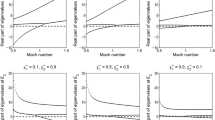The authors have presented results of mathematical modeling of collisions of inhomogeneous droplets of liquids (nonmixed two-fluid droplets and emulsions) in a gas medium between each other. A study was made of the influence of a set of factors on the conditions and integral characteristics of disintegration: of the temperature of the external medium, the concentration of the steam, and the Weber number. The obtained results have shown a satisfactory correlation with experimental results. It has been established that the ratio of the areas of the evaporation surface after and before the interaction as a result of the collisions of inhomogeneous droplets corresponds to the range 0.8–2. It is the central collision of droplets that is the most efficient. Critical values of the Weber number were established above which the ratio of the areas of evaporation surfaces of the droplets after and before the interaction S1/S0 remains constant, in practice.
Similar content being viewed by others
References
Z. Zeng, A. Sadeghpour, and Y. S. Ju, Thermohydraulic characteristics of a multi-string direct-contact heat exchanger, Int. J. Heat Mass Transf., 126, 536–544 (2018).
K. V. Dobrego, V. F. Davydenko, and I. A. Koznacheev, Use of oriented spray nozzles to set the vapor–air flow in rotary motion in the superspray space of the evaporative chimney-type tower, J. Eng. Phys. Thermophys., 89, No. 1, 157–166 (2016).
R. J. Romero and A. Rodríguez-Martínez, Optimal water purification using low grade waste heat in an absorption heat transformer, Desalination, 220, 506–513 (2008).
P. R. Von Rohr, K. Prikopsky, and T. Rothenfluh, Flames in supercritical water and their applications, Stroj. Cas., 59, 91–103 (2008).
D. Stefanitsis, I. Malgarinos, G. Strotos, N. Nikolopoulos, E. Kakaras, and M. Gavaises, Numerical investigation of the aerodynamic breakup of Diesel and heavy fuel oil droplets, Int. J. Heat Fluid Flow, 68, 203–215 (2017).
Z. Tianwei, L. Hao, H. Zhiyue, D. Zhiming, and W. Yong, Active substances study in fire extinguishing by water mist with potassium salt additives based on thermoanalysis and thermodynamics, Appl. Therm. Eng., 122, 429–438 (2017).
G. V. Kuznetsov, M. V. Piskunov, and P. A. Strizhak, How to improve efficiency of using water when extinguishing fires through the explosive breakup of drops in a flame: Laboratory and field tests, Int. J. Therm. Sci., 121, 398–409 (2017).
O. V. Vysokomornaya, M. V. Piskunov, and P. A. Strizhak, Breakup of heterogeneous water drop immersed in high-temperature air, Appl. Therm. Eng., 127, 1340–1345 (2017).
M. James and S. S. Ray, Enhanced droplet collision rates and impact velocities in turbulent flows: The effect of polydispersity and transient phases, Sci. Rep., 7, Article No. 12231 (2017).
A. Soni, V. Sanjay, and A. K. Das, Formation of fluid structures due to jet–jet and jet–sheet interactions, Chem. Eng. Sci., 191, 67–77 (2018).
V. A. Arkhipov, S. S. Bondarchuk, A. S. Usanina, and G. R. Shrager, Influence of the viscosity of a liquid on the dynamics of spreading of its drop, J. Eng. Phys. Thermophys., 88, No. 1, 42–51 (2015).
V. N. Khmelev, A. V. Shalunov, R. N. Golykh, V. A. Nesterov, R. S. Dorovskikh, and A. V. Shalunova, Providing the efficiency and dispersion characteristics of aerosols in ultrasonic atomization, J. Eng. Phys. Thermophys., 90, No. 4, 831–844 (2017).
V. A. Arkhipov, I. M. Vasenin, and V. F. Trofimov, Stability of colliding drops of ideal liquid, J. Appl. Mech. Tech. Phys., 24, 371–373 (1983).
R. S. Volkov, G. V. Kuznetsov, and P. A. Strizhak, Influence of droplet concentration on evaporation in a high- temperature gas, Int. J. Heat Mass Transf., 96, 20–28 (2016).
N. Shlegel and P. Strizhak, Collisions of water drops in a gas–vapor environment at high temperatures and vapor concentrations, Therm. Sci., 25, 3441–3451 (2021).
D. V. Antonov, N. E. Shlegel, and P. A. Strizhak, Secondary atomization of gas-saturated liquid droplets as a result of their collisions and micro-explosion, Chem. Eng. Res. Des., 162, 200–211 (2020).
N. D. Agafonova and I. L. Paramonova, Estimation of the drop size in dispersed flow, J. Eng. Phys. Thermophys., 89, No. 4, 840–847 (2016).
C. Hu, S. Xia, C. Li, and G. Wu, Three-dimensional numerical investigation and modeling of binary alumina droplet collisions, Int. J. Heat Mass Transf., 113, 569–588 (2017).
R.-H. Chen, W.-C. Wang, and Y.-W. Chen, Like-drop collisions of biodiesel and emulsion diesel, Eur. J. Mech. B/Fluids, 60, 62–69 (2016).
A. Munnannur and R. D. Reitz, A new predictive model for fragmenting and non-fragmenting binary droplet collisions, Int. J. Multiphase Flow, 33, 873–896 (2017).
Author information
Authors and Affiliations
Corresponding author
Additional information
Translated from Inzhenerno-Fizicheskii Zhurnal, Vol. 96, No. 5, pp. 1255–1265, September–October, 2023.
Rights and permissions
Springer Nature or its licensor (e.g. a society or other partner) holds exclusive rights to this article under a publishing agreement with the author(s) or other rightsholder(s); author self-archiving of the accepted manuscript version of this article is solely governed by the terms of such publishing agreement and applicable law.
About this article
Cite this article
Antonov, D.V., Fedorenko, R.M. & Strizhak, P.A. Mathematical Modeling of Binary Collisions of Inhomogeneous Particles of Liquids in a Gas Medium. J Eng Phys Thermophy 96, 1246–1256 (2023). https://doi.org/10.1007/s10891-023-02790-1
Received:
Published:
Issue Date:
DOI: https://doi.org/10.1007/s10891-023-02790-1




